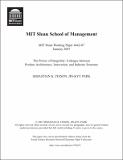| dc.contributor.author | Fixson, Sebastian K. | |
| dc.contributor.author | Park, Jin-Kyu | |
| dc.date.accessioned | 2007-04-13T18:57:42Z | |
| dc.date.available | 2007-04-13T18:57:42Z | |
| dc.date.issued | 2007-04-13T18:57:42Z | |
| dc.identifier.uri | http://hdl.handle.net/1721.1/37154 | |
| dc.description.abstract | A substantial literature stream suggests that many products are becoming more modular over
time, and that this development is often associated with a change in industry structure towards
higher degrees of specialization. These developments can have strong implications for an
industry’s competition as the history of the PC industry illustrates. To add to our understanding
of the linkages between product architecture, innovation, and industry structure we study an
unusual case in which a firm – through decreasing its product modularity – turned its formerly
competitive industry into a near-monopoly. Using this case study we explore how existing
theories on modularity explain the observed phenomenon, and show that most consider in their
analysis technological change in rather long-term dimensions, and tend to focus on efficiencyrelated
arguments to explain the resulting forces on competition. Expanding on these theories
we add three critical aspects to the theory construct that connects technological change and
industry dynamics. First, we suggest re-integating as a new design operator to explain product
architecture genesis. Second, we argue that a finer-grained analysis of the product architecture
shows the existence of multiple linkages between product architecture and industry structure, and
that these different linkages help explain the observed intra-industry heterogeneity across firms.
Third, we propose that the firm boundary choice can also be a pre-condition of the origin of
architectural innovation, not only an outcome of efficiency considerations. | en |
| dc.language.iso | en_US | en |
| dc.relation.ispartofseries | MIT Sloan School of Management Working Paper | en |
| dc.relation.ispartofseries | 4642-07 | en |
| dc.subject | Product Architecture | en |
| dc.subject | Integrality | en |
| dc.subject | Modularity | en |
| dc.subject | Technological Change | en |
| dc.subject | Intra-industry Heterogeneity | en |
| dc.subject | Industry Structure | en |
| dc.subject | Competition | en |
| dc.subject | Strategy | en |
| dc.title | The Power of Integrality: Linkages between Product Architecture, Innovation, and Industry Structure | en |
| dc.type | Working Paper | en |
